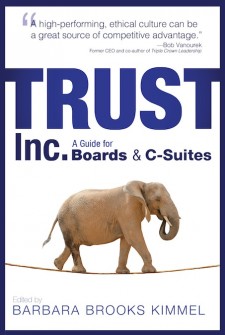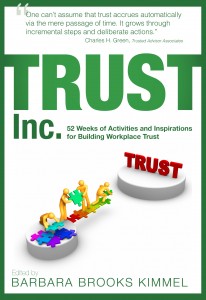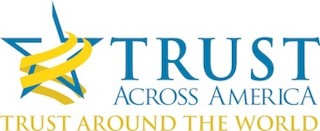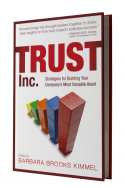Archive
Posts Tagged ‘corporate responsibility’

If a brand genuinely wants to make a social contribution, it should start with who they are, not what they do. For only when a brand has defined itself and its core values can it identify causes or social responsibility initiatives that are in alignment with its authentic brand story. Simon Mainwaring
We know that trust is built in incremental steps via a holistic approach that begins with leadership voluntarily choosing to make trust a business imperative. In other words, trust and trustworthiness become core values. Many companies, however, choose to view trust through the narrow lens of corporate social responsibility. They measure their good citizenship according to the number of boxes they check on the various independent surveys and standards of “proper behavior,” and then they use the awards and rewards in their messaging to their stakeholders. Sadly a good percentage of these programs in no way reflect the overall health of the company, and fall very short on gauging the trustworthiness of the organization. One need only look at some of the corporate names that rise to the top of annual “Best of CSR” lists to reach the same conclusion.
Over the past ten years much has been written and debated about corporate social responsibility programs and check the box practices:
2005 The Myth of CSR
Corporate Social Responsibility A Study of Key Features, Benefits, Criticism and the Various Initiatives.
CSR, The Dangers of Doing the Right Thing
Corporate Social Responsibility: An Overview
At Trust Across America-Trust Around the World, we have been tracking the trustworthiness of almost 2500 public companies over the past five years using our proprietary FACTS Framework. In reviewing the data, what’s often clear is that many of the companies using CSR success as the gold standard of good business are falling far short in other areas of corporate health. Let’s not forget that Enron claimed to have one of the best CSR programs.
Where does CSR end and moral responsibility begin? Does CSR distract the public from asking deeper ethical questions. Does it similarly distract Boards of Directors and C-Suites?
Many claim that any corporate program that “betters” society is good, but not everyone agrees on what is “better” or good. We argue that the betterment of society is not enough. Core values hold the key.
It would behoove leadership to look deeper into trust as a holistic business imperative. Exercising does not ensure good health. Eating well, lowering stress and getting enough sleep are just as important.
Barbara Brooks Kimmel is the Executive Director of Trust Across America-Trust Around the World whose mission is to help organizations build trust. She is also the editor of the award winning TRUST INC. book series. In 2012 Barbara was named “One of 25 Women Changing the World” by Good Business International.
Nominations are now being accepted for Trust Across America-Trust Around the World’s 5th annual Global Top Thought Leaders in Trustworthy Business.



Coming Soon!
Should you wish to communicate directly with Barbara, drop her a note at Barbara@trustacrossamerica.com
Copyright © 2014, Next Decade, Inc.
Barbara Brooks Kimmel, barbara kimmel, Board of Directors, corporate citizenship, corporate responsibility, CSR, leadership, organizational trust, trust, trust across america, trust in business, Trust Inc. 52 Weeks of Activities & Inspirations for Building Workplace Trust, Trust Inc. A Guide for Boards & C-Suites, Trust Inc. Strategies for Building Your Company's Most Valuable Asset, values

Late last year Trust Across America-Trust Around the World published the first in a planned series of award-winning books. TRUST INC., Strategies for Building Your Company’s Most Valuable Asset brings together the wisdom of 32 experts. Six months later we released our second book, Trust Inc. A Guide for Boards & C-Suites. In this book, sixty experts have joined forces to offer 100 strategies.
Throughout the month of August, we will be featuring 31 essays from our second book. Each stands alone as an excellent resource in guiding Boards and C-Suites on driving a trust agenda at the highest level in the organization, and provides tools for those who choose to implement trust-building programs in their organization.
This ninth essay in our series brings advice from Professor David Grayson CBE, Director the Doughty Centre for Corporate Responsibility, Cranfield School of Management, UK. Professor Grayson was named a 2014 Top Thought Leader in Trustworthy Business.
Towards a Board Mindset for Corporate Sustainability
To restore trust, boards must discharge their responsibility for the company’s Social, Environmental and Economic Impacts (Corporate Responsibility). For many companies and boards, however, there is still a critical mind-set shift that has to occur. Specifically, the shift from the idea of boards as mentors or monitors, stewards or auditors, to mentors and monitors, stewards and auditors. And a second shift from the idea of corporate responsibility as being about risk mitigation to the recognition that to be truly embedded, it has to become both risk mitigation and opportunity maximization: not minimizing negative Social, Environmental and Economic Impacts, but also maximizing the positive impacts.
The board sustainability mindset, therefore, can be defined as:
A collectively held view that long-term value-creation requires the company to embrace the risks and opportunities of sustainable development; and that the board are simultaneously mentors and monitors, stewards and auditors of the management in their commitment to corporate responsibility and sustainability.
Corporate responsibility and sustainability leadership and stewardship currently tends to come from the chairman or CEO or another board member, rather than yet being a collective mind-set of the board as a whole. Boards need to assess whether they have a Sustainability Mindset and, if not, identify how to create one perhaps through board away-days, scenarios presentations, creating a board sustainability advisory panel, and board recruitment, training and Continuous Professional Development, and appraisals. (Taken from Towards a Board Mindset for Corporate Sustainability, Jan 2013.)
I hope you have enjoyed this next sneak peak into our second book. If this brief look behind the door has been helpful, follow this link to order both of our books online.
Barbara Brooks Kimmel is the Executive Director of Trust Across America-Trust Around the World whose mission is to help organizations build trust. She is also the editor of the award winning TRUST INC. book series. In 2012 Barbara was named “One of 25 Women Changing the World” by Good Business International.
. 

Should you wish to communicate directly with Barbara, drop her a note at Barbara@trustacrossamerica.com
Copyright © 2014, Next Decade, Inc.
Barbara Brooks Kimmel, barbara kimmel, corporate responsibility, CSR, David Grayson, leadership, sustainability, trust, trust across america, trust in business, Trust Inc. A Guide for Boards & C-Suites, Trust Inc. Strategies for Building Your Company's Most Valuable Asset

What stops companies from building a culture of authentic long-term trust? As transparency increases, so does the ability of every citizen to look behind the curtain, with the click of a Google search.
I’m not trying to win a popularity contest with this blog post, at least not with corporate America. But hey, ask most C-Suite folks about trust issues in their organization and they won’t hesitate to emphatically tell you they have not a single one.
Last week I attended an event featuring two guest speakers (also sponsors) from large global companies in different industries. At the end of their respective speeches everyone in the audience applauded loudly except for me, and one other attendee. The other attendee “gets” trust like very few others. Based on their professional credentials, it’s understandable. Think nurse or military leader.
What made these speeches so excruciatingly painful?
First the canned, compliance-approved content, and second, the cult-like focus on the corporate responsibility programs of both organizations. While Trust Across America’s FACTS® Framework shows us that no company is perfect, both of the sponsor firms have recently paid massive fines for, let’s (politely) say, ethics violations. Not the first fine for either, and probably not the last, and just a mere “blip” on the quarterly earnings radar. So whom are they kidding? Judging from the applause, the vast majority of the audience.
As transparency increases, so does the ability of every citizen to look behind the curtain, with the click of a Google search. All it takes is a few minutes and a curious mind. Corporate responsibility is an important component of a trustworthy organization but it’s only one component. I’m not suggesting that companies air their dirty laundry in public. What I am suggesting is that they stop using the corporate responsibility officer as a public relations pawn. It may work now, but it is a short-term, unsustainable strategy. When the next ethics “oops” occurs, it may be the one that brings down the house, and nobody is going to care about the organization’s philanthropic efforts.
What if the C-Suite were to lead with a culture of trust by creating a long-term trust-building strategy and sent their CR officer into the field to talk about that instead? What if they discussed the company’s values statement or corporate credo, and how it meets the needs of all their stakeholders? What’s stopping companies from building their culture around authentic long-term trust? Is it the legal department?
And finally, the cherry on the weekly “trust cake” is contained in this article in which the author suggests that telling the truth undermines trust.
Next week is the start of spring. It’s also my birthday. Maybe the cake will be a bit less stale. Maybe the most popular flavor will change from artificial vanilla-coating to trust.
For more information on building trust in your organization you can read our new book, Trust Inc., Strategies for Building Your Company’s Most Valuable Asset.
Barbara Brooks Kimmel, barbara kimmel, corporate responsibility, CSR, ethics, FACTS(R), integrity, leadership, organizational trust, transparency, trust, trust across america, trust in business, Trust Inc. Strategies for Building Your Company's Most Valuable Asset







Recent Comments